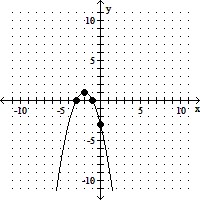Use the rational zeros theorem to determine the potential rational zeros of the polynomial function. Do not find the zeros.f(x) = -2x3 + 2x2 - 4x + 8
A. ±  , ±
, ±  , ± 1, ± 2, ± 4, ± 8
, ± 1, ± 2, ± 4, ± 8
B. ±  , ± 1, ± 2, ± 4
, ± 1, ± 2, ± 4
C. ±  , ± 1, ± 2, ± 4, ± 8
, ± 1, ± 2, ± 4, ± 8
D. ±  , ±
, ±  , ±
, ±  , ± 1, ± 2, ± 4, ± 8
, ± 1, ± 2, ± 4, ± 8
Answer: C
You might also like to view...
Use a commutative property to complete the statement. Do not simplify.7 + 4 = 
A. 4 - 7 B. 4 + 7 C. 7 ? 4 D. 7 - 4
Find the mean of the set of data. Round to the nearest tenth.13, 8, 14, 19, 4, 2, 4, 2, 20
A. 10.8 B. 9.6 C. 9.7 D. 9.4
Use the graph of the quadratic function to find the vertex, axis of symmetry, x- and y-intercepts, and domain and range.
A. vertex: (-2, 1) axis of symmetry: x = -2 x-intercepts: -1 and - 3 y-intercept: -3 domain: (-?, 1] range: (-?, ?) B. vertex: (1, -2) axis of symmetry: x = 1 x-intercept: -3 y-intercepts: -1 and - 3 domain: (-?, ?) range: (-?, 1] C. vertex: (-2, 1) axis of symmetry: x = 1 x-intercepts: -1 and - 3 y-intercept: -3 domain: (-?, ?) range: (-?, 1) D. vertex: (-2, 1) axis of symmetry: x = -2 x-intercepts: -1 and - 3 y-intercept: -3 domain: (-?, ?) range: (-?, 1]
Find the exact value of the indicated trigonometric function of ?.sec ? =  , ? in quadrant IVFind tan ?.
, ? in quadrant IVFind tan ?.
A. - 
B. - 
C. - 
D. - 